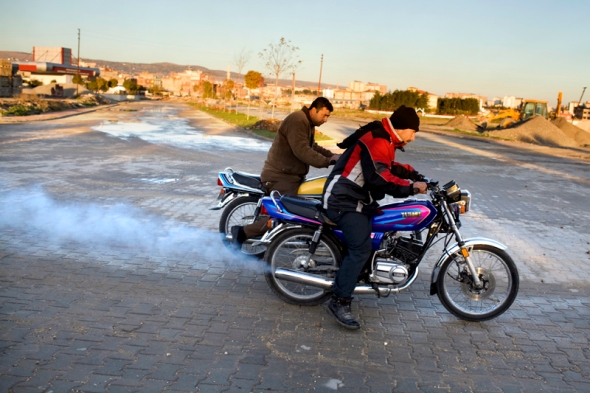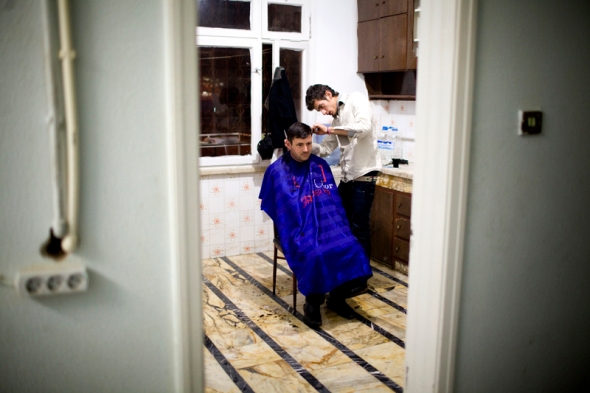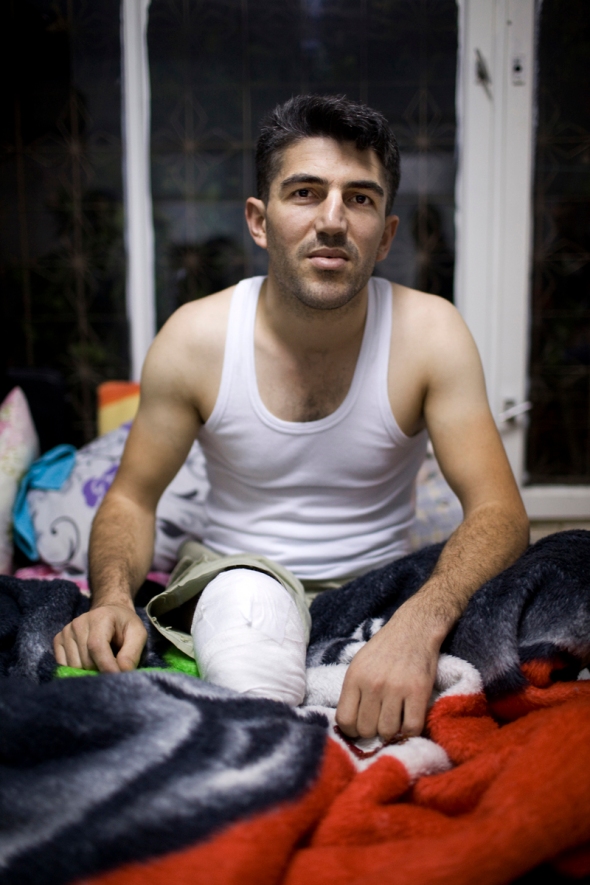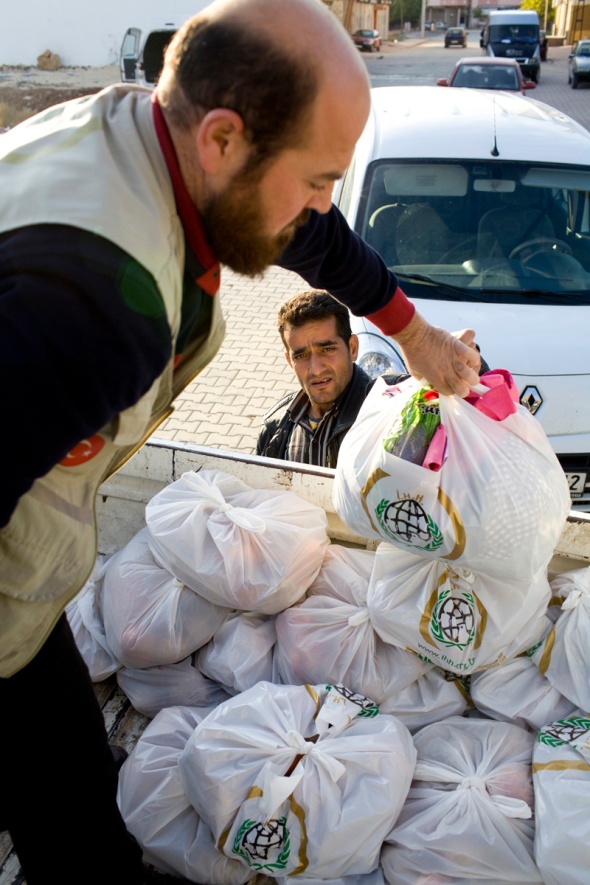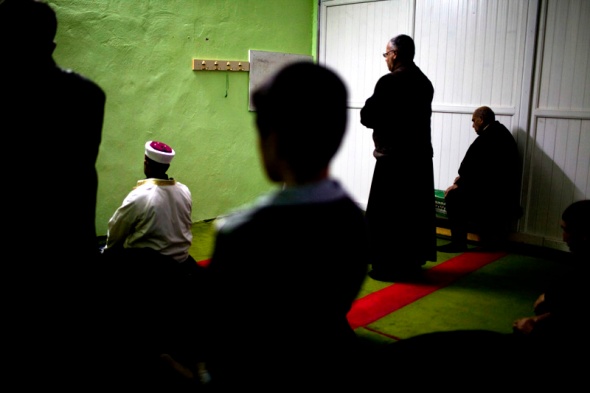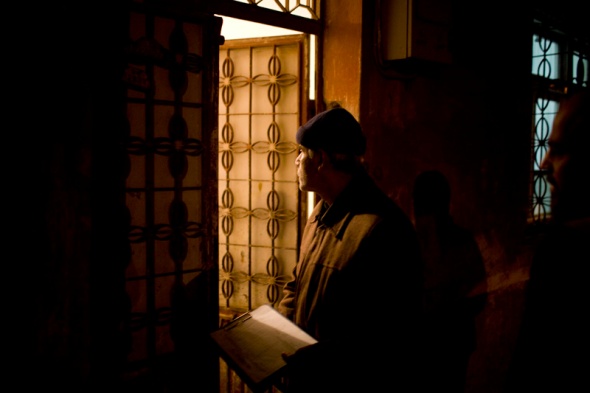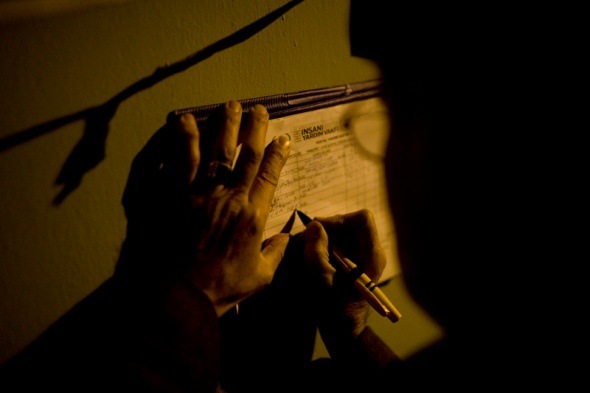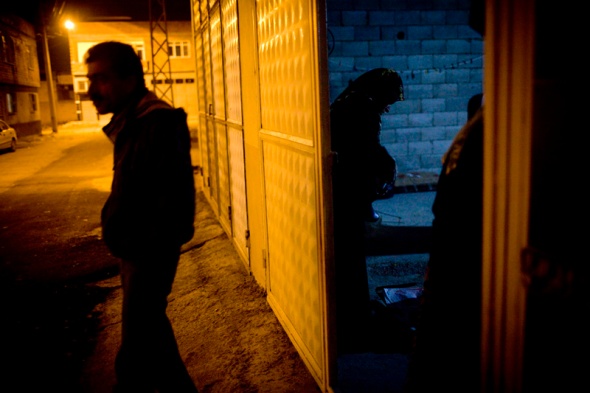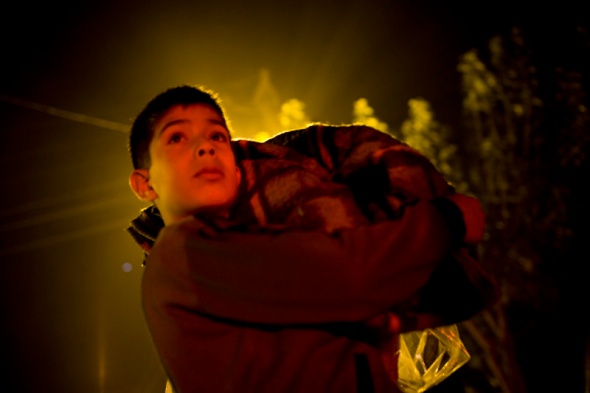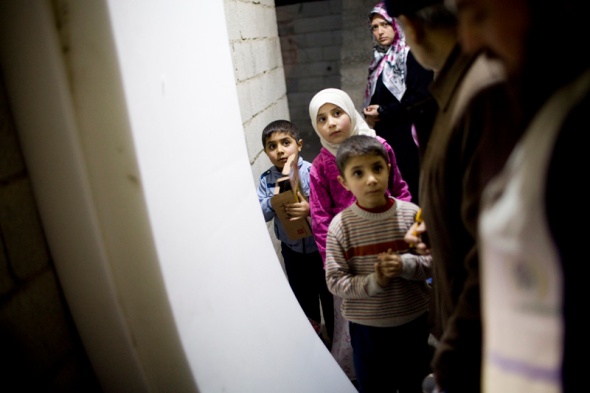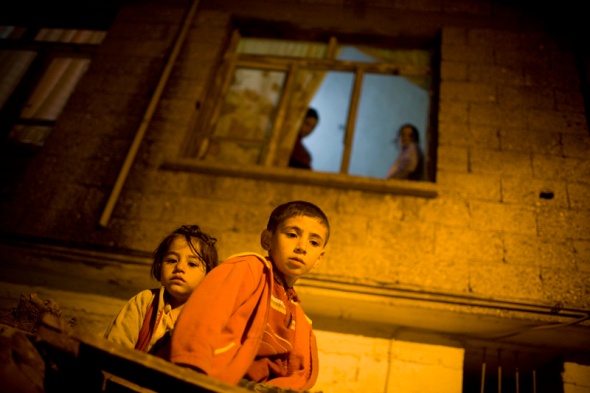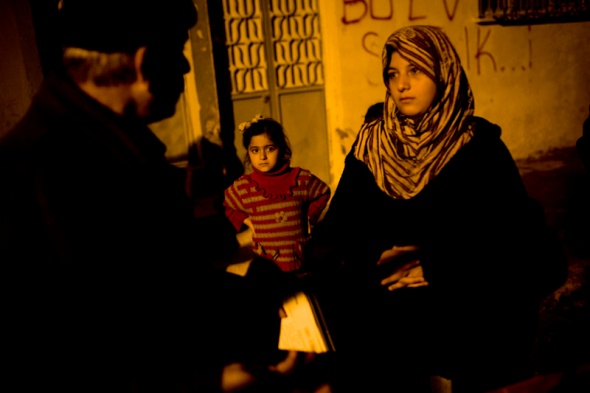Off to Roskilde Festival
I’ll be photographing at the Roskilde Festival again this year for Modkraft.dk.
It’ll be a mix of concert photography and news stories, and with a line-up including Paul McCartney, Florence + The Machine, Barrington Levy, Einstürzende Neubauten and many, many more it should be a blast! It’s my 16th year at the festival, and (as usual) what I am looking forward to the most is all the amazing people you meet and share some amazing musical moments with.
Here’s to you guys…
Portraits of Journalist and Writer Lone Theils
I’ve been photographing crime writer, journalist and kickboxing extraordinaire Lone Theils for Dagbladet Information, working withJannie Schjødt Kold who wrote a splendid feature on life, correspondency and Lone’s new book “Pigerne fra Englandsbåden” (English edition imminent I’m sure).
Film Director Kristian Levring

I’ve been photographing film director and co- Dogme founder Kristian Levring for Børsen Weekend.
Kristian’s newest film, the Western ‘The Salvation’ premiered at Cannes this week, and he’s definitely the coolest guy in the West (Hampstead that is…)
Summer Jobbing

I’ve been shooting a few newspaper assignments over the summer. Mostly it’s been portraits as it often is working for the dailies (around 90% of all assignments are portrait related when working in the newspaper industry). It’s always interesting meeting new people and trying to create something in a limited space as well as time with a few, simple remedies. Often the only thing you have available to create something special is light, and in that way it’s one of the purest forms of photography. Not that I’m particularly good at shooting portraits, but I do enjoy it!
Firstly I shot a series at the British Library of a Polish artist couple, Malgosia and Jakub. They showed me a secret garden at the top of the library which was amazing but I promised Malgosia not to tell anyone about it, so can’t say any more I’m afraid.
A week later I went to West London and met with Kasia and her daughter and did a series of them for an article about why immigrants (me included) chose to stay in London instead of going back home.
Finally I went on the hardest assignment so far this year. It was for a story about one of the so-called “transition towns” that are shooting up all over Britain. Smaller towns trying to prepare themselves for another recession by becoming economically self-proficient so they won’t be depending on outside resources for survival (no, we’re not talking doomsday preppers here, simply straight thinking ordinary folks trying to create a bit of balance in the system). This sounded like a dream assignment as there ought to be plenty to shoot, but unfortunately it was also one of those assignments that just didn’t work out because of timing. None of the projects were up and running when I arrived and many wouldn’t be for the next couple of years as it’s all about long-term investments. No matter, I’ll be back to shoot this again. This is what I got (and yeah, I am very pleased with the dog)…
Seeing The World
I’ve recently begun teaching a short course at London College of Communication.
I’ve always loved to teach but this is the first time where I’m leading the students through from the beginning to the end and it amazes me how much I learn from them and their progress each time. I love the connection that you get with the students as you share the world of photography through their work as well as through the historical representation of imagery.
It’s great to see students who come from a non-photographic background suddenly finding a voice of their own and create beautifully photographed stories with amazing storytelling as well.
Up until now they’ve covered subjects through their work ranging between everything from Jewish minorities, mans impact on nature, the notion of Home and the pugs role in British culture. Wow…
Here’s a selection of images from the course.
One of the main things we work with on the course is the development and execution of a personal story chosen by each student. We try to help each other develop this story and to find new approaches to the storytelling, locating right formula for each documentary project. The number one thing I try to teach is that it’s all about the storytelling!
Matthias Brücke’s story of Roehampton is a good example of this. A housing project there once build as a futuristic dream of togetherness now stands as a symbol of a time there once was…
The next course starts the 2nd of September at LCC and you can find the course description here.
Arabia Felix p. 1
“The depth of the Syrian tragedy is poignantly reflected in the accounts of its victims. Their harrowing experiences of survival detail grave human rights violations, war crimes and crimes against humanity. The destructive dynamics of the civil war not only have an impact on the civilian population but are also tearing apart the country’s complex social fabric, jeopardizing future generations and undermining peace and security in the entire region.”
Report of the independent international commission of inquiry on the Syrian Arab Republic
United Nations General Assembly
Human Rights Council
Twenty-second session
Agenda item 4
A/HRC/22/59
——————————————————————————————————–
We tend to see the frame as the image itself, objectifying the photograph instead of looking through it to understand.
Often our imagery is produced by highly educated “seers” as a product of a civilisation that have been taught to view the world in a singular way.
These Polaroid’s are shot in and around Syria in 2012/2013 and are all relating to the ongoing conflict. Each Polaroid have been exposed as well as composed correctly, but the exposed negative has never been removed from the photographic paper.
Right after the moment of exposure the Polaroid has been handed over to people present in the situation with a request for them to write on the back of the picture. No direction or explanation of what to write has been given, this has been left completely up to the individual.
“These are the mortar shells of Bashar that hit the house in the village of Al Hibat and resulted in a number of injured people and two women martyrs.”
“This is the body of a woman who was killed by a mortar shell that fell on their house and killed this mother of seven.”
“The army killed us in our houses and we became homeless and I became disabled for life because of shrapnel and I lost my father and my mother who were killed by the Syrian army. Our thanks to Denmark.”
“Abu Jameel is a rocket warrior”
[blank]
“Khalid Hmaydo”
“Bab El Salama”
“Bab El Salama”
“At five in the morning we were awaken by the sound of a Russian plane then it fired a missile”
“A MiG plane dropped 4 missiles in the region of Hibat”
Work in Progress

Here’s an extract from my latest project from Syria that should be ready for publication within the next two months.
Broken Boy Soldiers
A dark, starless night wraps its arms around us. We are floating in its deep, black nothingness and only the white reflective lines on the asphalt road caught in the one surviving headlight reveals our movement. We are rapidly being absorbed into the Syrian night, removing our self with increasing speed from the relative normality that comes with the Turkish border.
It’s been a while since we last passed the burning oil drums marking the start and end of cities, all revealing bearded faces of city elders that peer out of the darkness, the red warmth of the fire reflecting in their eyes. They stop us: Who are we? Or more importantly, who are we not? The two people in the front seats are well known faces on these roads so we continue onwards.
Momen and Yahoo are members of the Tawheed Brigade and fights for the revolution. Yahoo is 21 years old and experienced. He used to be a fighter, but due to his technologic abilities, he is now in charge of media and communication. Yahoo is driving the car. Moomen is 16 and carrying the Kalasnikhow. They are best friends.
A few hours earlier, walking down the main street of the Turkish border town Reyhanli, I stopped at a street stall selling army fatigues and belts for ammunition. I had recognized a black nylon vest with pockets on the front and back large enough to hold AK47 magazines and grenades.
This type of vest is the highest fashion among the rebels along with the black headscarves that carry the Shahaada (Muslim declaration of faith) in white writing.
A couple of men come up and look at the headscarves. With their long white robes and full-grown beards they are as foreign as me. They smile and I smile back. They are here to join the rebels and crossing over the border today. They ask me to come with them, but to their disappointment I politely decline and explain that I already have made arrangements. We wish each other safe travels and as I turn the corner I find my Syrian contact waiting for me.
As we approach the border barrier on foot I see a sea of faces through the metal bars marking the end of Turkey. A policeman stands blocking a small opening in the gate, not letting anybody in. We sneak behind a truck and walk up to the guard with our heads down. My friend grabs my arm and starts to press through the opening. The officer barely notices us. He’s too busy keeping the many Syrians out of Turkey to notice anybody trying to get in. Why would he?
This is the first time I’ve been smuggled over a border and I can feel the adrenalin pumping. The contrast of this other territory hits me immediately when we enter…
Stay tuned for the publication of the full story shortly.
Maggie & Me
I shot Margaret Thatchers funeral for Danish newspaper Information. Here’s my view of the day…
Polaroids
These Polaroids are shot during my travels in Syria in 2012/2013. This is an ongoing project.
The Sichuan Quake
As we are coming up to the five year mark of one of the worst natural catastrophes in our time, I thought I would revisit my work from the 2008 earthquake that hit the Sichuan province in China.
I was visiting China with journalist Lisa Ioannou as we were working on a story about industrial pollution and it’s impact on newly born babies.
We were in the middle of checking in to a hotel many hundred kilometres away from the epicentre when the highrise began to sway. It only lasted for a few minutes and afterwards we were laughing with the locals in the street, relieved that it was over and there were no harm done.
Little did we know of the horror and incredible tragedies that were playing out simultaneously in the neighbouring region.
An estimated 68.000 lives were lost.
Another shot for Danish Daily Information
I was commissioned to shoot another series of images for Danish newspaper Information recently.
This story is about young, well educated southern Europeans emigrating to northern Europe in the search for jobs. Me and journalist Mette Rodgers had a chat with Sofía Vieira, Roberto Cacabelos Bote, Tamara Guerrero Feijóo and Raquel Vazquez Santos, a group of friends that have left Spain to try their luck in London.
Here’s a selection.
Back In Syria
I’ve been back in Syria since Saturday, doing a so-called ‘NGO-run’ with a Danish charity. We’ve been at a few refugee camps and also visited a string of hospitals. Mostly we’ve been in meetings trying to arrange the next batch of emergency relief.
Now I’m back in the country, this time on my own. I am travelling the Idlib province with a group of rebels called the Tawheed Brigade. I am gathering photos as we go along and working on a range of different projects but as I’ve been feeling a little like a photojournalistic cliché lately (that not necessarily meant as a bad thing) I’ve decided to do an old school black and white series for the first blog.
Hope to have some more time soon to get the different pieces together, but right now it’s all loose strings tying them selves together here and there and not always in the right order, so bear with me while I find myself in this mess of a conflict…
Sikh Wedding
I’ve been working with my good friend and talented photographer Esther Sabetpour on a few of her wedding jobs lately. Esther specializes in Asian weddings and has an amazing technique that especially comes out in her portraits.
These pictures are some of my contribution to the latest Sikh wedding that I helped with. Such a big experience!
Portrait Session in Westminster

Danish Daily Information commissioned me to shoot a portrait of Tory MP William (Bill) Cash. It was one of those jobs that started out with an interview and normally I welcome that as I find it interesting as well as a good way of warming the subject as well as my self up for the shoot itself.
This time it didn’t go quite that way.
Westminster where the interview took place have very strict rules on photography so I were only allowed to shoot in Westminster Hall after the interview. I’ve looked through the EXIF data and I had less than two minutes for this shoot before Cash decided that time was up. Luckily I’ve been in this situation quite a few times by now and as so often before, preparation is the key.
I knew what image I wanted walking into the hall (the first one) and the two others are simple backup shots. I found myself lucky when shooting the horizontal portrait as a flash from a tourists camera bounced off my subject as I hit the shutter, giving the image that little extra edge that I like.
Sometimes you use three hours on getting that one good shot, sometimes you get it in two minutes.
Drinking Tea with the Rebels

I’m back in Turkey. Hotel. Bed. Facebook. A friend request pops up, name written in Arabic. It turns out it’s a captain in the Free Syrian Army that I met earlier in the day. He’s stationed in Aleppo but has one night off to see his wife and four kids that are in Gaziatep, a large city just 20 kilometers from Kilis, Turkey.
He tells me that I should get to the Syrian city of Azaz tomorrow by 8 a.m. as there should be a funeral for an FSA soldier.
At 6 a.m. I wake up the receptionist to check out of my hotel and at 7 I wake up the Turkish border official to check out of Turkey.
Inside Syria I decide to go straight through the border area and find a car that can take me to town. I negotiate a price of 10 Turkish Lira (£3) and am about to jump in the car as a man in army fatigues carrying a Kalashnikov stops me. I need permission to leave the area and there’s no way around the media center.
While we wait for the media center to wake up the soldiers manning the control post invite me in for breakfast consisting of flat bread with spicy pickles and hot Arab tea cooked on a large gas burner standing between the two beds and a television that frames the room. The sweet tea cheers us all up and I start feeling less grumpy about being withheld. They don’t speak any English and I’ve soon used up my one Arabic word saying “Shukran” (thank you) every time I can get away with it. We still have a good time though and after a while I start playing around with my camera to see what reaction that will bring. As I hoped it doesn’t take long before they are posing and I’m snapping away freely.
It starts to pour. Again. It has been raining almost every single day since I arrived at the border. I curse my suede shoes for the tenth time on this trip, and stop. Realizing that all my worries have a warm bed, a bankcard, wireless Internet and a Christmas full of food and presents waiting just a few hours away. In the meantime a large queue has gathered outside in the rain. Men, women and children are getting drenched as they wait for the weekly handout of diapers…
I meet with my media “escort” from the day before and he tells me that the body of the captain is still in Turkey. They don’t know when he’ll be buried as his mother is on her way to the hospital to say her final goodbyes. Not much to argue about there, so I fold out my umbrella and go exploring in the camp.
Life Changes in an Instant
I spend the day organizing. First of all I need to change hotels. The one I’ve been staying in for the last two nights costs 90 Turkish Lira, about £30. My previous one was only £13. I’m here on my own budget so money matters every single step of the way.
People here are always offering to take me to Aleppo. I’m tempted but at a price of 300 American dollars each way for the 40km drive, it’s simply not possible for me. The steep price also indicates the level of danger. I met an Italian photographer that had been there. While I share a beer with Michele he tells me of his eight hours trip. The way that he grasps his head and looks down while he explains how a bomb landed just two blocks away says it all. It’s not worth going. From his eyes I can see that he is right.
After changing hotels I work for a few hours. The organizational side of things takes up a lot of my time and with the sun setting around four I have to be economical with the hours. When done I grab my camera and head out to locate a NGO run medical clinic for Syrians injured by the war.
On my way there I collect imagery not directly connected to the Syrian conflict. These pictures are meant for another project in my diary build on a scientific exploration of the so-called ‘Arab Felix’ that was sent by Danish king Frederick V in 1776 to explore the Arabian Peninsula.
I come across sheepherders and men blowing out the engines on their Yahama 4-gears. For these people this is just everyday life. But for me as a foreigner this is something absolutely stunning. It’s the power of looking, catching a glimpse and trying to comprehend.
A man in an impeccable suit stops on his motorbike. He talks to me in Turkish. I smile and say ‘hospital’ and he gestures me to get on. He speeds up and the wind in my face feels great.
We get to a three-storage house looking stranded. The wall is crumbling and Syrian number plates identify the cars parked outside. Inside is another world. Four small rooms are packed with hospital beds. In each bed lies someone wounded in one way or the other by the Syrian conflict. Some are FSA soldiers, some aren’t. Some are civilians and others are not. One thing that almost all of them share is that they’re just kids…
While I talk to patients that have lost arms and legs in the constant Aleppo bombing, a guy sees me and starts to yell. He’s angry and aggressive. I’m guessing that he is not Syrian, as he looks different from everybody else here. He shakes one of his crutches at me and I walk away.
“Don’t mind him, he’s just al-Qaeda” the other patients explains.
It’s clear that they don’t like him much. I ask if there are many al-Qaeda warriors in Syria and they tell me that there’s quite a few. Right now they are all fighting Bashar al-Assad, so it’s okay. But when the fighting is over and the winner has to be found they will become a problem.
“I’m Syrian and a Muslim and I am scared of them” one of the wounded tells me.
The Dull Sound of Bombing
At the border I meet a photojournalist. He’s rough looking, missing a few teeth and wearing bulletproof gear. He looks at my thin leather jacket and then my blue eyes.
“You don’t have any combat gear? Anything warmer than that?” He asks me with a British accent. I don’t.
“Go with your gut-feeling mate, if you feel scared, turn away. And good luck!”
Right now I’m about to do exactly that. Just turn away and go back to where I came from. Someplace safe.
It’s a five kilometres walk through concrete and barbed wire from Turkey to Syria. Green grass grows on both sides of the road. There’s a mosque, a graveyard and then a few red signs warning trespassers of mines.
In the other end a big, newly printed banner welcomes me to a Free Syria. The empty frame where Bashar al-Assad used to greet visitors from now hangs empty. Someone is yet to fill this gap.
The new bureaucrats are young. Laughingly they throw passports back and forth between the desks and I get my stamp. Right across the border a mini version of a village has been erected by the use of white plastic tents donated by charities. Roughly 6000 people live here.
First stop is the Free Syrian Army’s media centre. Six men hang around, watching European football on a flat-screen television. My passport as well as press card are photocopied, we have tea, they ask me a few question, assign me a press officer and then we are off.
The camp is drenched. Even though there is only a limited number of tents for the many families, many of them stands empty due to flooding. It has been pouring for the last three days and today is the first with a bit of sun. All over clothes hangs to dry and small barriers of sand lies in front of each to try and keep some of the water out.
The refugees in this camp come mostly from the rural area around Aleppo. These people were not rich before the uprising and don’t have a passport. Without passport there’s no access to Turkey. The kids are in sandals and their clothes are drenched. Smilingly they run after me and throw me the V-sign every time I raise the camera. This is hard.
A few hours later the sun begins to set. I decide to head back to Turkey, hoping that re-entry won’t be a problem. As the sun throws its last long shadows and the Turkish half moon shows in the distance, a deep rolling thunder sends me on my way. Even though I’ve never heard real bombs go off before, there’s no doubt in my mind. This is real. This is war…
Meeting the Syrian Refugees
About 30.000 Syrian refugees are believed to have made their way across the Turkish border into the city of Kilis. Most of them have arrived within the last four months. Basic necessities such as shoes and coats are in demand as winter approaches and already now the temperature reaches zero.
After a 19 hours bus ride I finally reach Kilis. It’s 12am and the sun is shining. It’s warm in that special way where you can tell that winter’s coming. With 90.000 inhabitants this is considered a small town. Through history Kilis has belonged to the Ottoman district of Aleppo. The newly established Republic of Turkey led by famed first president Atatürk took over the city after World War I. The Syrian border is only five kilometers from the city center and an hours drive after that lies Aleppo where some of the fiercest battles between government forces and the rebels are taking place as I write this.
My contact Hamza, that works for IHH (the Turkish NGO that VIOMIS cooperates with) picks me up at the station. We drive to the small headquarter on the outskirts of town and while I’m served kebab and sweet Turkish tea the daily activities start to increase.
Outside in the small courtyard, white plastic bags carrying the IHH logo are being filled with potatoes and unions. Large boxes of plastic wrapped foam mattresses as well as blankets and donated clothing are being loaded on to a small truck. One of the many daily loads of emergency relief is on its way to the many Syrian refugees that live scattered across town.
I’m introduced to Omar and Mahmoud that are both Syrian refugees themselves and now works for IHH, helping others in the same situation. These two are in charge of today’s distribution, so I leave my bags behind, grab my camera and jump in the car with them.
Every day the relief is distributed in a new area of the town. To find the many Syrian families they have to work closely with the areas Mokhtar. A Mokhtar is the head of an area within the city. There’s about 30 Mokhtars in Kilis, and it’s their responsibility too keep track of people and resolve disputes within their designated area.
On our way through the city we share stories about ourselves to break the ice. Omar finds it hard to believe that I am neither Christian nor Muslim and while his smiling eyes starts to glow he tells me of the many glories of Islam.
“Insha’Allah (god willing) Anders, maybe when you see the work we do here you will also become Muslim, Insha’Allah” he says.
Soon we come across the first Syrian refugees and with much heartache I see that they lack even the most basic remedies. Clothing, shoes and food are highly in demand. It’s cold here in Kilis, down to three Celsius, and children as adults are in sandals. It’s hard to be here, eye to eye with people in such distress. Suddenly reality becomes real and far removed from television images and newspaper articles. They are right here, these people that had to leave everything behind and are now facing a harsh winter and an uncertain future.

Both Omar and Mahmoud have only been in Kilis for four months so it can be difficult for them to find their way.
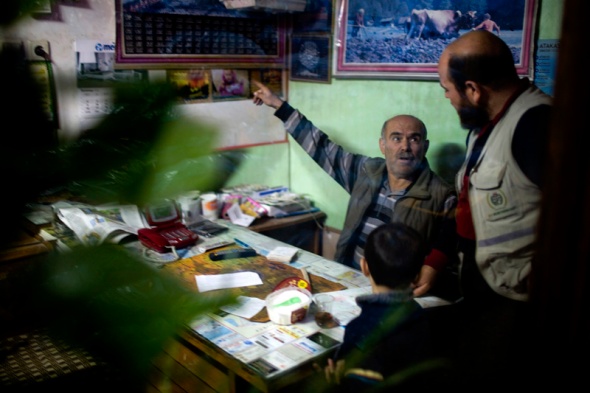
As Turkish and Arabic are two very different languages, communication often slows down the relief effort.
Istanbul is a Feeling, an Impression and a Steppingstone
The first time I was here I was 12. Memories of smog, crowds, kebab and an incomprehensible wait for the telephone to connect to my mom in Denmark are left behind and 19 years later it’s a different city. The calls for prayer and the scent of apple tobacco are still the same but now they float through streets occupied by men in cravats and women with and without hijabs lunching at trendy cafes next to designer shops and photo galleries showcasing the latest from the international art scene.
As the plane approaches the airport it is increasingly clear to me that this is a metropolis with a responsibility. A responsibility to keep two parts of the world together so they don’t drift too far from each other, but also a responsibility to keep them separate so we still can tell them from us and us them.
Bosphorus is the name of the strait that cuts through the giant. With a head in one part of the world and a body in another the strait is like an aorta that pumps life into the Turkish economy as well as to the oil market in Europe via tankers full of the black Russian gold.
Also for the individual Bosphorus is a vein of life. All along the many kilometers of coastline couples promenade while local fishermen sells their catch of the day. Tivoli’s offer entertainment while small ferries sail back and forth non-stop, working as needle and thread tying these two continents together.
While the empty bottles on the table in front of me goes from one to two, ships slowly drift by in the night. Across the strait thousands of lights waver and then disappear one by one as we pass midnight. A new day is coming and one thing is for sure. Istanbul is neither Asian nor European, Istanbul is it’s own.
The First Step
Chris Rea’s playing ‘Driving Home for Christmas’ while I’m eating a sandwich from the bar. Around me, men sits alone, starring into their gadgets, as do I. It’s almost empty here at night and only the letters written on luminous blue signs reveals my location. Ataturk airport, Turkey.
Through the last week I’ve been on constant standby. The bureaucracy took it’s turn and demanded extra approval of documents, keys and copies. Finally everything got sorted and I got my ticket. Copenhagen to Istanbul, one-way…
The last ambulances are being prepared for shipping.
Officially I’m sent by the NGO VIOMIS (Knowledge about Islam) to document the distribution of emergency relief collected in Denmark. Personally I’m here to understand.
It all started in October 2011 where I traveled to Damascus. This was while the media were still referring to the conflict as an uprising and to Assad as a despot who’s days were numbered before the end of the year. Back then there were no signs of unrest in Damascus and the fighting in the North only came in to the living rooms through the state lens. The Christian family that gave me shelter were faithful to Bashar al-Assad and did not like their Muslim neighbours.
Abu Bashir and Khalid Alsubeihi from VIOMIS are planning the last details before departure.
This was a city under siege, not by guns but by fear. Under the many watchful eyes of Assad, people lived in fear of what would come. I believe that many of the inhabitants went to bed at night wishing not for a victory for one part or the other, just that it would all be over soon.
A year later about 100 people die every day in Syria. Aleppo’s still the front line and there are not many visible cracks in the Assad facade. The everyday atrocities have become exactly that. Everyday. The news current has turned and now runs over the next conflict.
After arriving in Istanbul the emergency relief has another 1200 kilometers of transport before reaching the Syrian border.
Left behind is the Syrians with an opposition as divided as the international community who’s diverging interests slowly but surely are ripping the country apart. The only thing that seems certain is that the end game, when it comes, won’t be peaceful. Through this journey I hope to connect with some of the people directly affected by this conflict and through their stories try to understand as well as disseminate a reality that is here, now.
Off to the Syrian border
In five hours (6 am) I’ll be on my way to Gatwick Airport to catch a flight to Denmark. There I’ll be joining a group of Danes from the organization VIOMIS (Knowledge about Islam) that have managed to raise enough money to buy six ambulances and a bunch of medical equipment that they’ll be transporting down through Europe to the Syrian border in Turkey. Hereafter all the equipment will be donated to Syrian hospitals that are fighting a daily battle to safe as many lives as possible in what rapidly is turning in to one of the worst humanitarian catastrophes in the so called Arab Spring.
I will join them, document their efforts and blog about our travels here on the site (in English) and (in Danish) on Modkraft.dk
For now just a quick series of shots of what I’ll be bringing. I have chosen to leave most of my equipment at home and do this one as low key as possible as I don’t know what situations will arise on the way. All I know is that I have a ticket home from Jordan in mid December.
I will write more on this in the following days as I meet up with the volunteers.
Apologies for the poor image quality, but I should have been in bed by now. Also, I’m bringing my 5D MII, not planning to shoot the whole thing on the Polaroid.
Hope you’ll follow the progress here over the next couple of weeks…
















































































![[blank]](https://andersbirger.files.wordpress.com/2013/08/ab-polaroids-web-5.jpg?w=590&h=886)

























































































